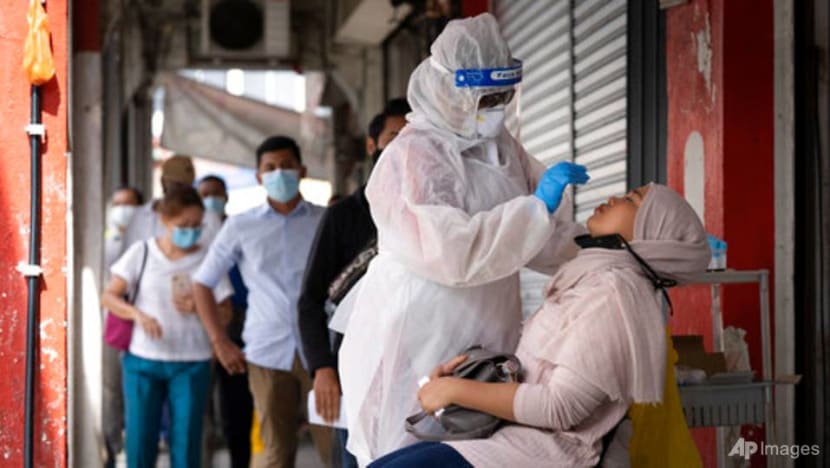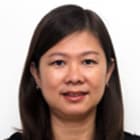Commentary: Creating more permanent posts won't solve Malaysia’s contract doctor problems
After contract doctors staged a walk-out last year in the midst of the COVID-19 pandemic, the Malaysia government created more permanent posts. This won’t be enough if scores of medical graduates continue to enter the healthcare system, says journalist Loh Foon Fong.

A doctor collects a sample for a coronavirus test outside a clinic in Kajang on the outskirts of Kuala Lumpur, Malaysia, on Oct 23, 2020. (Photo: AP/Vincent Thian)
KUALA LUMPUR: The annual intake of students into medical schools in Malaysia began in March and will continue until September. Thousands are expected to enrol, despite their predecessors – now in contractual positions at government hospitals - expressing frustrations about job security.
This is notwithstanding the fact that the Malaysia government had announced 11,000 new permanent positions, mostly for doctors, in February.
With 15,000 to 18,000 medical graduates expected to start housemanship from 2023 to 2025, coupled with 23,000 contract doctors as of 2021, there are still way too many doctors who will be vying for the limited permanent posts in the public sector.
By 2025, some 30,000 doctors are expected to remain as contract doctors. Doctors say it’s not clear where most contract doctors have gone after their contracts ended, but some had joined the private health sector, pharmaceutical companies or taken up non-medical jobs.
If the yearly massive influx of medical students is not addressed, there will be no end to Malaysia’s contract doctor problem.
Before the government’s recent announcement, no permanent jobs had been created after it cut spending and imposed a freeze on civil service positions in 2015. Doctors were offered only contracts (for two years after two years of housemanship) as they waited for permanent doctors to retire or resign so they could take those few places.
As a result, the public healthcare system consists of 41 per cent contract medical workers. Health minister Khairy Jamaluddin said from 2016 to 2021, only 1,118 doctors, 1,019 dentists and 1,288 pharmacists were appointed to permanent posts.
CONTRACT DOCTORS’ FRUSTRATIONS BOILING OVER
And frustrations boiled over after months fighting at the frontlines of the pandemic alongside permanent doctors, but with less pay and benefits.
In July 2021, amid the rising Delta surge, many contract doctors went on a symbolic strike to call out the unequal pay, lack of job security and limited career progression.
And the government seems to have taken heed. Following the strike, it extended contracts by another two years, and another four years and the possibility of applying for federal scholarships if they were accepted for specialist studies, something only permanent doctors were entitled to do previously.
In February, Mr Khairy said his ministry had recommended a “New Deal” to the Cabinet. While mid- and long-term solutions were being worked on, the government agreed to open up 4,186 permanent positions in 2022 (mostly medical officers, with a few for dentists and pharmacists) and at least 1,500 new permanent posts created each year from 2023 to 2025. For the same period, more than 800 specialist posts will be added each year.
In all, the health ministry estimated RM3.4 billion (US$780 million) will be spent to create the 11,296 additional permanent posts starting this year until 2025.
WILL NEW PERMANENT DOCTOR POSTS BE ENOUGH?
What difference will the newly created posts make? For one, the 3,586 permanent positions for medical doctors that will be created this year should help, considering 5,000 housemen enter the service annually and some vacancies are expected from resignations, the Malaysian Medical Association (MMA) president Dr Koh Kar Chai told me.
Even then, MMA claimed that 533 doctors’ applications for the opening of permanent posts were rejected with no reason given. The Public Services Commission (PSC) gave reassurance that it will submit the list of 3,281 candidates who failed the vetting process to the Ministry of Health for final screening, according to Bernama.
However, Dr Koh also said the 1,500 new permanent positions to be created from 2023 until 2025 are “not enough” and “a big drop” from the number created in 2022.
He pointed out that the private sector cannot absorb the large number of contract doctors who resigned or completed their contracts as they were likely to practise in cities and towns, where there are already too many private clinics.
Private hospitals need more specialists, so medical officers, if recruited, are confined mostly to the limited spots in emergency departments and wellness centres, he added.
More contract doctors should be made permanent doctors in view of Malaysia’s growing and ageing population, rising prevalence of non-communicable diseases, and the lack of specialists and doctors, especially in rural areas. And this is on top of having to deal with COVID-19 as Malaysia transitions to an endemic phase.
The dire COVID-19 situation in July and August 2021 when there was a severe lack of medical personnel, ambulances, oxygen tanks and hospital beds should remind us of the need to be equipped adequately for a pandemic.
Patients had to be ferried from hospital to hospital in search of a bed; some died while waiting for an ambulance that arrived hours later. Medical personnel also suffered from burnout, trauma and depression.
CREATING MORE POSTS WITHOUT EASING DEMAND ISN’T THE ANSWER
Despite the need for more permanent doctors to meet the stipulated needs from 2023 to 2025, the limited number of training hospitals cannot cope with too many medical graduates, which has snowballed for more than a decade.
Medical graduates have to wait nine months to a year to start their housemanship, with no guarantee that they will get a permanent medical officer post.
Training hospitals take time to build – a new hospital in Sabah was officially launched in 2018 and is expected to be completed in 2023 after the timeline changed several times. More trainees mean more instructors are needed too.
But when the sink is overflowing, we must turn down the tap, not put out more pails. The government needs to cut down the number of students entering medical studies after factoring in the needs of the country. Otherwise, this will continue to burden the healthcare system.
Meanwhile, the private sector should also be held responsible for the medical students they churned out. If a private medical school does not have its own hospital to absorb some of the doctors they produced, there should be a cap on the number it produced.
HIGHER ENTRY REQUIREMENTS FOR MEDICAL SCHOOL?
Malaysia has nearly achieved the government’s target of 1 doctor to 400 patient ratio. Former health minister Dr Adham Baba said, in 2020, that Malaysia had 71,041 medical doctors working in both public and private sectors, making a ratio of one doctor for every 454 people.
It is now a matter of getting them distributed more equally throughout the country.
Although Malaysia has some brilliant medical graduates, with some employed by hospitals in Singapore and other countries, not all cope well in hospital training. A quarter of housemen had been reported in the past to have dropped out.
Senior doctors have been calling upon the government to impose an aptitude test and a higher entry requirement on all potential medical students. There are a handful of Malaysian universities that had imposed an aptitude test and the test can be standardised and adopted nationally.
An aptitude test could add some friction to the process and better select students who are committed doing medical studies and ready for the high demands of training, or risk getting stuck in a rut.
By doing proper manpower planning and limiting the number of medical students to those with good grades and the needed aptitude, the government saves itself from being overwhelmed by too many housemen and needing to provide permanent posts to too many doctors.
Managing the number of students entering medical studies has to be done as soon as possible or more doctors’ lives will be in limbo. And that will ultimately be a problem for patients and Malaysia.
Loh Foon Fong is a senior freelance health journalist based in Malaysia.



















